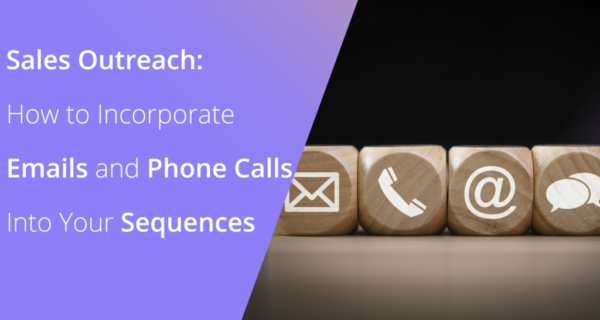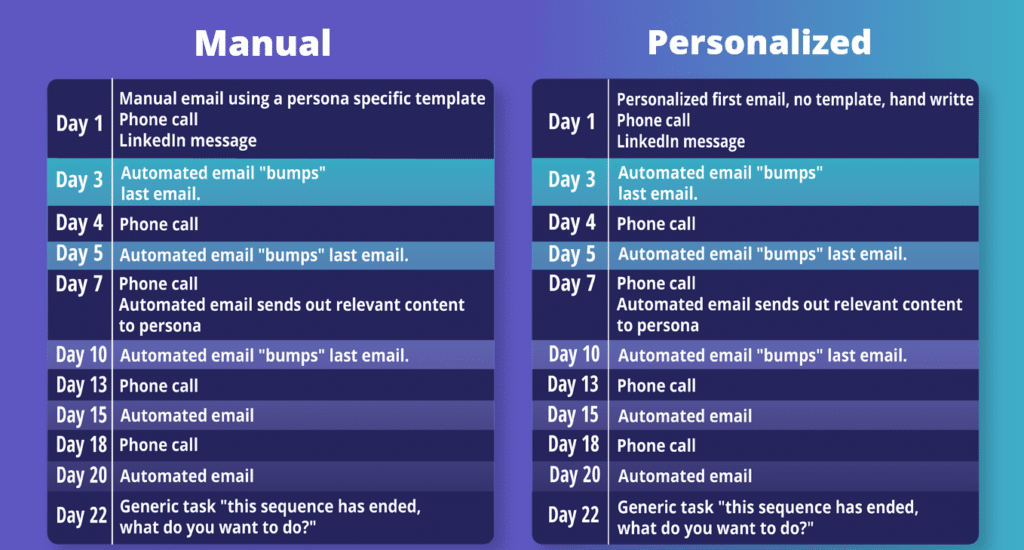Sales Outreach: How to Incorporate Emails and Phone Calls Into Your Sequences
You’ve heard of sequences, right? They are an integral part of your sales outreach and a magical combination of touchpoints to your prospects that, if all goes well, will result in a REALLY good sales call. Recently, the AMAZING Brooke Bachesta of Outreach, aka the gurus of outreach and sequences, and I got together to talk about how to build the perfect sequence! Brooke (who also happens to be a #GirlsClub Gen 1 graduate) is a wealth of knowledge and we were so lucky to grab a little time with her. Okay, it’s time to get into the good stuff!
Let’s start with the basics…
What is a sequence?
A sequence is a repeatable set of steps used to connect with potential customers. These could be a manual list of emails that you send or reminders you set for yourself to connect on LinkedIn (Tip: it’s a heck of a lot easier if you use software like Outreach or additional tools that allow you to automate nearly everything!) Think of it as you setting your future self up for success.
When do we use sequences?
The idea behind a sequence is to connect with people who are not totally familiar with you or your company. So, you can (and should) be using a sequence in any of these situations:
- Top of funnel
- Prioritized prospecting
- Refining your ‘hit list’
- Cold Leads
- Warm Leads
- Account penetration
- Account revitalization
- Anyone else you’re not talking to on the regular
What is in a sequence?
The most successful sequences include a multi-channel campaign. When we say multi-channel, we mean a combination of email, phone calls, LinkedIn, direct mail, etc. Essentially, you want to use every available form of communication to try and find the one that will get you some virtual or live face time with your prospect.
What makes a GREAT sequence?
All of the following:
- A multi-channel campaign
- Phone, Email, LinkedIn, Text, Direct Mail, Carrier Pigeon (just kidding!), etc.
- About 2 weeks of effort before changing strategies
- 15+ touchpoints per contact
- 3 days or less between touchpoints
We get it, 15+ touchpoints in 2 weeks sounds like a lot, but we promise there is research to back us up. Skip Miller released a really great book called Outbounding. One of the things he found was that if you wait for more than 3 days between touchpoints the prospect is going to forget who you are. Think of it this way, even if your prospects are not responding to you, shortening the time between your reachouts helps them to at least have familiarity with your name. While they might not pick up on the first call, they may answer on the 5th call. With this under 3 3-day window, they are more likely to, at the very least, recognize your name and be more inclined to talk.
How can I write a really great sales email?
Spoiler alert! People don’t really care who you are or what you sell. So, we have to bring them in and smoothly transition right to the point. Great emails typically hit all of the following marks:
- 4-5 word subject line
- Creative & relevant content
- 150(ish) words total. We want it to be short enough to read on your phone
- Use the SWIIFT℠ Method (So What’s In It For Them) – learn more about SWIIFT℠ HERE
- Cleanly and uniformly formatted
- Stick to a structure:
- Make it personalized to them, their company, their industry
- Highlight the areas for potential pain
- Seamlessly transition to how you can help
- Provide relevant social proof
- Include a call to action
READ: How to Write Better Sales Emails: 12 Actionable Tips
How about voicemails, should you leave one?
YES! I beg you, please, leave voicemails EVERY. SINGLE. TIME. We’ve already mentioned that there are 15 touches in a good sequence. About half of those touches should be voicemails. You are already putting in the time, doing the research, and making the calls… but if you are not leaving a voicemail, then it’s like that phone call never happened.
Hot Tip: before picking up that phone for your first call of the day, make sure your voice is warmed up. Whether that first call results in a living, breathing human on the other end or a voicemail, if your voice cracks it’s not a good look (err, sound).
DOWNLOAD: 4 Voicemail Script Samples
What makes a great voicemail?
Here are some tips for leaving a great voicemail:
- Make it 10 seconds or less
- Put some personality in your message and don’t read directly from a script. Pretend you’re talking to your best friend
- Be clear in your messaging
In a great sequence, there will be about 7 phone calls. For most contacts that could equate to as many as 7 voicemails. So, switch up the message styles. My 4 favorite types of voicemails are:
- Urgency
- Mystery
- Value
- Lever
Insider Tip: in your sequence notes, keep track of the type of voicemail you leave. This will help you know what to say when they call you back and can help you find patterns in the styles of voicemail that are most successful for you. You can read more about my 4 favorite voicemails HERE.
Here are two examples of great sequences from our friends at Outreach:
What’s the difference between these two?
If you read through, you would think these two sequences are exactly the same. And they almost are, with one BIG difference: the 1st email. The “manual” sequence includes a templated email (that may have a tiny bit of personalization). While the “personalized” sequence, on the other hand, includes a truly personalized email, like one written from scratch.
When do you use each type?
You will likely find yourself using the manual sequence for the majority of your top-of-funnel, prioritized prospecting, when refining your ‘hit list’, and cold leads. The return rate on automated emails is roughly 1%. So, we don’t want to spend too much time writing a truly personalized email for an unqualified account.
Now, when we’re talking about account penetration and account revitalization, we would recommend a personalized sequence instead. For these types of prospects, you will likely have solid background information or have had prior contact with the recipient. Warm leads will likely fall under this category as well, especially if you have spent time speaking with them at say a conference or networking event.
*Gasp* your sequence worked and they answered the phone! Now what?
Before starting your call series you should craft a couple of standard (but still great) intros for when your prospect actually answers. The key is to remember not to sell in the intro, instead focus on helping. The goal of your intro is to get your foot in the door and to get your prospect talking. Selling comes later.
Here’s what a great standard intro is going to include:
- It should be short and focused on what’s in it for them (think SWIIFT℠)
- Includes the goal of the call
- Should end with a question
- The entire goal of your intro is to GET THEM TALKING
The questions you ask in your intro should be short and shouldn’t require too much thinking. We want to aim for yes or no questions, or questions that involve an auto-answer. Think things like “How many reps are on your team?”, “Are you outbound or inbound?”, “Looking to add a couple of new team members?” Get them talking and THEN we transition to the sales call.
WATCH: Quick Tips For Better Cold Call Openings
Wondering what NOT to include in your intro?
If you play your cards right, there will be plenty of time for selling either later in this first call, or during your follow-up (more tips on bridging to the follow-up call here). The first time your prospect answers the phone, your job is to get them talking and engaged. We’ve talked about what to do… now let’s touch on what NOT to do:
- No social proof
- No introducing yourself
- No value props
- No features or benefits
- Remember: Don’t sell – do help!
Shoving research in their ear as soon as they answer isn’t appealing. The prospect doesn’t care if you’re the regional vice president for the mid-coast Atlantic region of your company’s XYZ division. In the first 2 minutes of the call, they don’t care what your amazing features are. What they care about is getting their job done better, faster, and easier. So, let’s start out by showing them how we can help!
Remember, the whole purpose of a sequence is to amplify your already amazing sales skills and get you to the finish line faster. So when working on your sales outreach, take time crafting your initial sequence cadence and your templated emails (if you’re going the manual sequence route). Future you will say “Thank you!”
If you’d like even more information on crafting the perfect prospecting message or sequence, you can watch our whole session with Brooke HERE!

